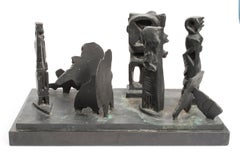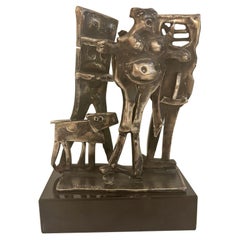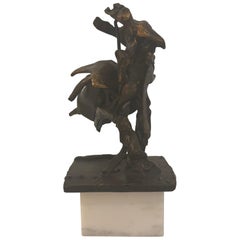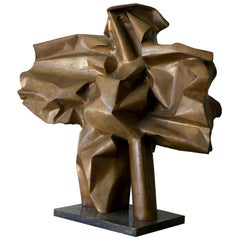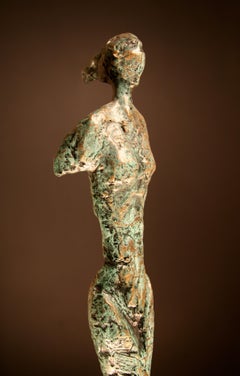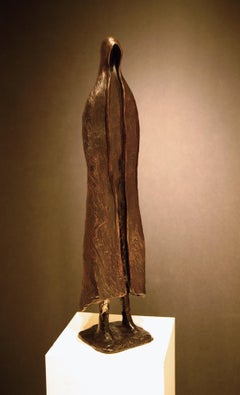Abbott Pattison Sculptures
1916-1999
Abbott Pattison was an American sculptor and abstract artist. After receiving his BFA from Yale in 1939 and a stint in the Navy, Pattison returned to his native Chicago. From the 1950s through the 1970s, he traveled to Italy to cast his one-off bronzes at the renowned Marinelli Foundry in Florence. Pattison's works are in the permanent collections of the Whitney, the Art Institute of Chicago, the Corcoran Gallery of Art and the Farnsworth Art Museum and among others.
to
2
1
1
1
Overall Width
to
Overall Height
to
5
2
1
1
1
1
4
4
3
3
9
214
196
162
132
5
Artist: Abbott Pattison
Brutalist Modern Abstract Bronze Sculpture Metropolis Manner of Louise Nevelson
By Abbott Pattison
Located in Surfside, FL
A very heavy, massive bronze sculpture by an important Chicago sculptor. Signed and marked "Firenze" with "Fuse Marinelli". METROPOLIS. Seven abstract shapes on black marble base. 1...
Category
20th Century Modern Abbott Pattison Sculptures
Materials
Marble, Bronze
"Summer/Indian Island" Silver Sterling Sculpture, Abbot Pattison (1916-1999)
By Abbott Pattison
Located in Palm Desert, CA
This rare sterling silver sculpture by American modernist Abbott Pattison features four stylized figures in an expressive Brutalist style—one of which appears to be an abstracted can...
Category
Mid-20th Century Abbott Pattison Sculptures
Materials
Marble
"Rape of a Sabine Woman" Bronze Sculpture, Abbott Pattison (1916-1999)
By Abbott Pattison
Located in Palm Desert, CA
This dynamic bronze and subtly polychromed sculpture by Abbott Pattison interprets the dramatic moment of the Rape of the Sabine Women—an iconic episode from Roman mythology—in a dis...
Category
Mid-20th Century Abbott Pattison Sculptures
Materials
Marble, Bronze
Abbott Pattison Sculpture Abstract Bronze Titled 'Flight' 1977, Large Scale
By Abbott Pattison
Located in Dallas, TX
Large scale one of a kind abstract bronze Mid-Century Modern sculpture commissioned by the CHICU corporation in LA and executed by Chicago artist Abbott Pattison in 1977.
Masterful...
Category
Mid-20th Century Abbott Pattison Sculptures
Materials
Bronze
Signed, 1970's Abstract Figurative Bronze Sculpture
By Abbott Pattison
Located in Los Angeles, CA
1970’s, leaping, bronze dog sculpture by highly respected, listed, American artist, Abbott Pattison (1916-1999). Select public collections: Whitney Museum of Art in New York City; t...
Category
20th Century Modern Abbott Pattison Sculptures
Materials
Bronze
Related Items
Bronze Sculpture “Arise”
By Frank Arnold
Located in Fresno, CA
Frank Arnold is thought by many to be one of the foremost abstract figurative painters and sculptors of our time. He is a living master whose work is considered to be both personal a...
Category
2010s Abstract Abbott Pattison Sculptures
Materials
Bronze
Bronze Sculpture “Understander”
By Frank Arnold
Located in Fresno, CA
Frank Arnold is thought by many to be one of the foremost abstract figurative painters and sculptors of our time. He is a living master whose work is considered to be both personal a...
Category
2010s Abstract Abbott Pattison Sculptures
Materials
Bronze
After Botero - Standing Woman Bronze Sculpture
By Fernando Botero
Located in Cuauhtemoc, Ciudad de México
This AFTER BOTERO sculpture is a very beautiful, faithful reproduction in the style of BOTERO'S work that has sold very well here on 1st Dibs.
The edition is 50 in Roman numerals. ...
Category
20th Century Contemporary Abbott Pattison Sculptures
Materials
Marble, Bronze
Arch, Sensual White Carrara Statuary Marble Stone Vertical Figurative Sculpture
By Lutfi Romhein
Located in Clermont-Ferrand, Auvergne-Rhône-Alpes
This Carrare statuary marble stone sculpture in a very pure white with slightly colored veins is by Lutfi Romhein.
A graduate from the Academy of Fine A...
Category
2010s Modern Abbott Pattison Sculptures
Materials
Marble
$5,896
H 27.56 in W 5.52 in D 4.73 in
Woman Lying Down & Growing with Tree bronze sculpture by Yulla Lipchitz
Located in Hudson, NY
Organic, abstract bronze sculpture by Yulla Lipchitz of a woman lying down with a tree.
About this artist: Yulla Lipchitz, née Halberstadt, was born on April 21, 1911 in Berlin, Ge...
Category
1970s Modern Abbott Pattison Sculptures
Materials
Bronze
$3,775
H 16 in W 7 in D 8 in
Communication
Located in Austin, TX
By Duff Browne
Marble sculpture on black marble base.
Dimensions: 17.5" H x 8" W
Category
21st Century and Contemporary Abbott Pattison Sculptures
Materials
Marble
1961 Coty Award Plaque Kenneth Hairdresser Jacqueline Onassis Bronze Fashion
Located in New York, NY
1961 Coty Award Plaque Kenneth Hairdresser Jacqueline Onassis Bronze Fashion
Bronze on wood. The wood plaque measures 12 3/4" by 20 3/4 inches. The bronze plaque itself is 13 3/4 x 8 3/4 inches and the the bronze inscription, which reads "COTY, American Fashion Critics Special Award 1961 to KENNETH of LILY DACHE...
Category
1960s American Modern Abbott Pattison Sculptures
Materials
Bronze
Bronze Sculpture 'Bolas IV' by Carola Eggeling, Bronze Patina
By Carola Eggeling
Located in Paris, FR
Bronze Sculpture 'Bolas IV' by Carola Eggeling
Abstract sculpture with beautiful curved lines.
German bronze sculpture
Bronze Patina
Certific...
Category
21st Century and Contemporary Abstract Abbott Pattison Sculptures
Materials
Bronze
$18,042
H 38.19 in W 3.15 in D 3.55 in
Earth - British Sculptor, Abstract, Marble, Italian Carrara, Philosophy, Figure
Located in Knowle Lane, Cranleigh
Earth by British sculptor Ian Thomson. Thomson's travels have provided inspiration for his work. He holds degrees in Architecture and Philosophy & describe...
Category
2010s Abstract Abbott Pattison Sculptures
Materials
Marble
$19,452
H 44.49 in W 7.88 in D 7.09 in
Past Lives
Located in BARCELONA, ES
According to reincarnation theory, there are lives previously lived in
different bodies.
Some people say they have memories of their past lives.
May be one of the reason that you fee...
Category
2010s Contemporary Abbott Pattison Sculptures
Materials
Marble, Bronze, Wire
Large Gilt Bronze Sculptures of Cheetahs
Located in Rome, IT
Fantastic pair of gilt bronze Cheetahs sculptures . The item will be well-suited to either an indoor or outdoor setting.
Category
Early 2000s Modern Abbott Pattison Sculptures
Materials
Bronze
Large Gilt Bronze Sculptures of Cheetahs
Located in Rome, IT
Fantastic pair of gilt bronze Cheetahs sculptures . The item will be well-suited to either an indoor or outdoor setting.
Category
Early 2000s Modern Abbott Pattison Sculptures
Materials
Bronze
Previously Available Items
Brutalist Modern Abstract Bronze Sculpture Metropolis Manner of Louise Nevelson
By Abbott Pattison
Located in Surfside, FL
A very heavy, massive bronze sculpture by an important Chicago sculptor. Signed and marked "Firenze" with "Fuse Marinelli". METROPOLIS. Seven abstract shapes on black marble base. 1...
Category
20th Century Modern Abbott Pattison Sculptures
Materials
Marble, Bronze
H 12.5 in W 22.75 in D 12.5 in
Abbott Pattison sculptures for sale on 1stDibs.
Find a wide variety of authentic Abbott Pattison sculptures available for sale on 1stDibs. You can also browse by medium to find art by Abbott Pattison in bronze, metal, marble and more. Much of the original work by this artist or collective was created during the 20th century and is mostly associated with the modern style. Not every interior allows for large Abbott Pattison sculptures, so small editions measuring 23 inches across are available. Customers who are interested in this artist might also find the work of Walter Furlan, Paul von Ringelheim, and David Adickes. Abbott Pattison sculptures prices can differ depending upon medium, time period and other attributes. On 1stDibs, the price for these items starts at $7,500 and tops out at $18,000, while the average work can sell for $12,750.
